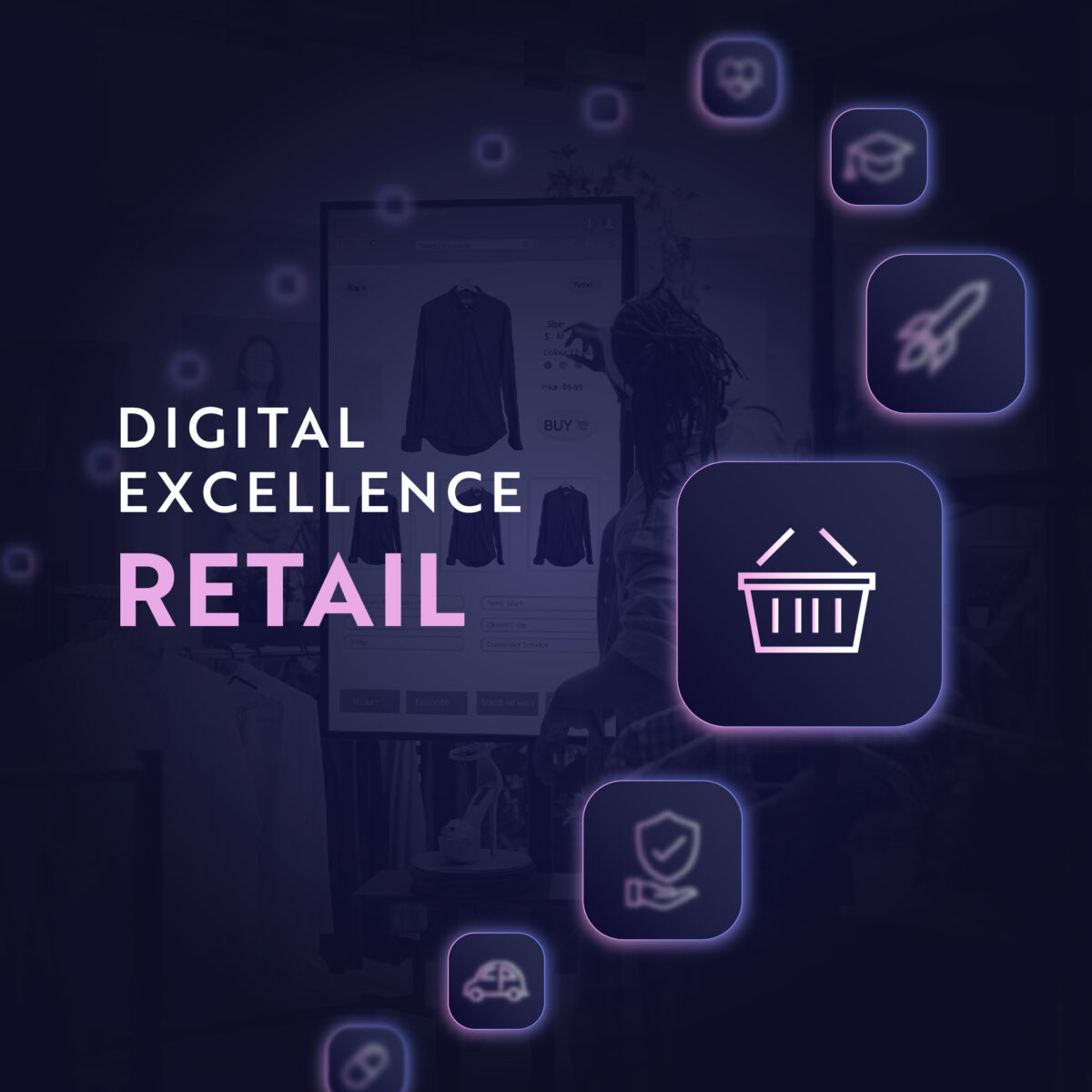
Impact Assessment: Key Technologies Transforming Retail Excellence
- E-commerce Platforms:
- Growth of Online Shopping: E-commerce platforms have revolutionized the retail landscape by providing consumers with the convenience of shopping from anywhere, at any time. Online sales have grown exponentially, driven by the increasing adoption of mobile devices and improved digital infrastructure.
- Integration with Physical Stores: Retailers are leveraging e-commerce platforms to extend their reach beyond physical locations, integrating online and offline experiences to offer a seamless omnichannel journey.
- Artificial Intelligence (AI):
- Personalized Marketing: AI algorithms analyze vast amounts of customer data to deliver personalized product recommendations, targeted advertising, and tailored promotions, enhancing customer engagement and loyalty.
- Inventory Management: AI-powered analytics optimize inventory levels, reducing overstock and stockouts, and enabling retailers to respond swiftly to changing demand patterns.
- Augmented Reality (AR) and Virtual Reality (VR):
- Immersive Shopping Experiences: AR and VR technologies allow customers to visualize products in real-world settings, such as virtually trying on clothes or previewing furniture in their homes. These immersive experiences increase customer confidence and drive higher conversion rates.
- Internet of Things (IoT):
- Smart Stores: IoT devices enable real-time data collection from connected sensors and devices within stores, providing valuable insights into customer behavior, inventory levels, and store operations.
- Enhanced Customer Interactions: IoT-enabled devices facilitate personalized interactions, such as smart mirrors and interactive kiosks, enhancing the overall shopping experience.
- Blockchain:
- Supply Chain Transparency: Blockchain technology enhances supply chain transparency and traceability, allowing retailers to verify the authenticity and origin of products, ensuring ethical sourcing and compliance with regulations.
- Secure Transactions: Blockchain provides secure, tamper-proof records of transactions, reducing the risk of fraud and increasing consumer trust.
Benefits:
- Improved Customer Engagement: Digital technologies enable retailers to connect with customers on a deeper level, offering personalized experiences that drive satisfaction and loyalty.
- Increased Sales and Revenue: By leveraging data-driven insights and targeted marketing, retailers can boost sales and revenue growth.
- Operational Efficiency: Automation and data analytics streamline operations, reducing costs and improving resource allocation.
- Enhanced Supply Chain Management: Technologies like AI and blockchain optimize supply chain operations, enhancing efficiency and reducing lead times.
Challenges:
- Data Privacy Concerns: The collection and use of customer data raise privacy concerns, necessitating robust data protection measures and compliance with regulations.
- Cybersecurity Threats: As digital technologies become more integral to retail operations, the risk of cyberattacks increases, requiring robust cybersecurity strategies.
- Continuous Technological Upgrades: The rapid pace of technological change demands continuous investment in new technologies and infrastructure to remain competitive.
Strong Use Cases
- Personalized Shopping Experiences:
- Retailers like Amazon and Netflix use AI to analyze customer data and provide personalized recommendations, enhancing the shopping experience and increasing customer retention.
- Omnichannel Retailing:
- Brands like Nike and Apple have successfully integrated their online and offline channels, offering customers a seamless experience that allows them to shop, purchase, and return products across multiple platforms.
- Smart Inventory Management:
- Retailers like Zara use IoT sensors and AI analytics to monitor inventory levels in real time, enabling them to optimize stock levels, reduce waste, and improve supply chain efficiency.
Compelling Case Studies for Retail Excellence
1. Sephora: Leveraging AR for Virtual Try-Ons
Sephora has successfully integrated AR technology into its mobile app, allowing customers to virtually try on makeup products using their smartphones. This innovation has enhanced customer engagement by providing a fun and interactive shopping experience, leading to increased conversion rates and customer satisfaction. Sephora’s approach demonstrates the potential of AR to revolutionize the retail industry by offering personalized and immersive experiences.
2. Walmart: AI-Powered Supply Chain Optimization
Walmart, one of the world’s largest retailers, has embraced AI and machine learning to optimize its supply chain operations. By analyzing vast amounts of data, Walmart’s AI systems predict demand patterns, optimize inventory levels, and improve supply chain efficiency. This has resulted in reduced costs, minimized stockouts, and improved customer satisfaction, positioning Walmart as a leader in leveraging technology for competitive advantage.
The Role of Digital Maturity Index (DMI) Assessments in Retail
In today’s competitive retail landscape, digital transformation is crucial for success. Digital Maturity Index (DMI) assessments offer a structured framework for evaluating a retailer’s digital capabilities across various dimensions, such as strategy, technology, operations, and customer experience. By assessing digital maturity, retailers can gain insights into their strengths, weaknesses, and opportunities for improvement, enabling them to strategically navigate the complexities of digital transformation.
DMI assessments provide valuable benchmarking against industry peers and competitors, allowing retailers to understand their relative position in the market. This comparison highlights areas where they excel and identifies gaps that need attention. By pinpointing specific dimensions of digital maturity, retailers can develop targeted strategies and allocate resources effectively to drive digital excellence and business performance.
With insights gained from DMI assessments, retailers can create strategic roadmaps that outline the steps needed to advance their digital capabilities. These roadmaps set clear objectives and prioritize initiatives that align with business goals, ensuring that digital transformation efforts are focused and impactful. As retailers achieve higher levels of digital maturity, they can deliver superior customer experiences, optimize operations, and enhance their competitive position in the market.
Overall, DMI assessments are a powerful tool for retailers seeking to enhance their digital capabilities and achieve long-term success. By leveraging these assessments to guide their digital transformation journey, retailers can strengthen their competitiveness and position themselves for sustainable growth in a rapidly evolving industry.
Elevate Your Retail Strategy with Digitopia’s DMI Assessment
Digital Maturity Index (DMI) offers a comprehensive evaluation of your digital capabilities, tailored specifically for the retail industry. With actionable insights and benchmarking against industry peers, you can identify key growth areas, chart a clear path to digital excellence.
Main Recommendations
- Embrace a Customer-Centric Approach:
- Focus on understanding and anticipating customer needs through data analytics and personalized marketing. Develop strategies that prioritize customer experience and engagement.
- Integrate Digital Channels:
- Develop a seamless omnichannel strategy that combines online and offline experiences to enhance customer convenience and satisfaction. Ensure that all touchpoints are interconnected and provide a consistent brand experience.
- Invest in Advanced Technologies:
- Allocate resources to adopt cutting-edge technologies like AI, IoT, and AR to stay ahead of the competition. Continuously assess emerging technologies and their potential impact on the retail industry.
- Utilize the Digital Maturity Index (DMI):
- Conduct regular DMI assessments to benchmark digital capabilities, identify gaps, and create strategic roadmaps for transformation. Use these assessments to guide decision-making and prioritize digital initiatives.
- Foster a Culture of Innovation:
- Encourage experimentation and agility within the organization to adapt to changing market dynamics and consumer preferences. Create an environment that supports innovation and rewards creative problem-solving.
Conclusions
The retail industry is undergoing a profound transformation driven by digital innovation. By embracing digital technologies and focusing on customer-centric strategies, retailers can unlock significant business value and maintain a competitive edge. Executives must prioritize digital transformation initiatives and leverage tools like the Digital Maturity Index to guide their journey toward digital excellence. In doing so, they can not only meet evolving consumer expectations but also drive sustainable growth and profitability.





















